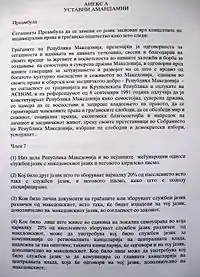Ohrid Agreement
The Ohrid Framework Agreement (Macedonian: Охридски рамковен договор, romanized: Ohridski ramkoven dogovor) was the peace deal signed by the government of the Republic of Macedonia (now North Macedonia) and representatives of the Albanian minority on 13 August 2001. The agreement was signed by the country's four political parties after international mediators demanded their commitment to its ratification and implementation within a four-year period.[1]
 Annex of Ohrid Agreement | |
| Type | Peace agreement |
|---|---|
| Signed | 13 August 2001 |
| Location | Ohrid, North Macedonia |
| Original signatories | Government of the Republic of Macedonia (now North Macedonia)
|
Provisions
The Ohrid Agreement created a framework for North Macedonia as a civic state.[2] It established basic principles of the state such as cessation of hostilities, voluntary disarmament of ethnic Albanian armed groups, government devolution, and the reform of minority political and cultural rights.[3] It ended the armed conflict between the National Liberation Army and the security forces of North Macedonia.
The Agreement also included provisions for altering the official languages of the country, with any language spoken by more than 20% of the population becoming co-official with the Macedonian language at the municipal level.[3] Only the Albanian language, with an approximate 25% of the population being speakers, currently qualifies as a co-official language under this criterion.[4] The Agreement is an example of the adoption of consociationalism.[5]
According to the document, the English-language version is the only authentic version of the Ohrid Framework Agreement. The Government of North Macedonia had to adapt the Constitution of North Macedonia in order to provide the Albanian minority living in North Macedonia with fifteen basic rights. The lead negotiator, on the behalf of the European Union, was François Léotard, with James W. Pardew, who had been dispatched by Secretary of State Colin Powell, representing the United States.[6]
Notes
- Dimova, Rozita (2013). Ethno-Baroque: Materiality, Aesthetics and Conflict in Modern-Day Macedonia. New York: Berghahn Books. p. 131. ISBN 9781782380405.
- Caspersen, Nina (2017). Peace Agreements: Finding Solutions to Intra-state Conflicts. Cambridge, UK: Polity Press. p. 76. ISBN 9780745680262.
- Watkins, Clem S. (2003). The Balkans. New York: Nova Science Publishers, Inc. p. 113. ISBN 1590335252.
- Brunnbauer, Ulf (2002). "The implementation of the Ohrid Agreement: Ethnic Macedonian resentments" (PDF). Journal on Ethnopolitics and Minority Issues in Europe (1/2002). Archived from the original (PDF) on 2015-09-23. Retrieved 2015-05-18.
- Fontana, Giuditta (2016). Education Policy and Power-Sharing in Post-Conflict Societies: Lebanon, Northern Ireland, and Macedonia. Springer. p. 102. ISBN 978-3-319-31426-6.
- Laurence Cooley (2018). The European Union's Approach to Conflict Resolution: Transformation Or Regulation in the Western Balkans?. Routledge. p. 103. ISBN 978-1-138-48719-2.
External links
- Ohrid Framework Agreement Text in English
- Ohrid Framework Agreement Text in Macedonian
- Ohrid Framework Agreement Text in Albanian
- Florian Bieber et al., Power Sharing and the Implementation of the Ohrid Framework Agreement, Friedrich Ebert Stiftung - Office Macedonia, Skopje, 2008.
- Marija Risteska and Zhidas Daskalovski (eds), One decade after the Ohrid Framework Agreement: Lessons (to be) learned from the Macedonian experience, Friedrich Ebert Stiftung, Center for research and policy making, 2011.
- Blerim Reka (ed.), Ten years from the Ohrid Framework Agreement, South East European University, Tetovo, 2011.